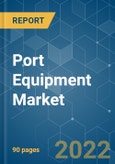The port equipment market is anticipated to register a CAGR of about 4%, during the forecast period (2020 - 2025).
Key Highlights
- Some of the major factors driving the growth of the market are growing trade relations between countries. Primary factor for all trade is the mode of transport and distance. Cost effective transport enhances trade activities with lesser time, low traffic and congestion along with the ability to manage more cargo. With this advantage over other modes, marine trade activities are gaining popularity on a global scale.
- Asia-Pacific is expected to witness a high growth rate during the forecast period.But because of the trade tensions between US and China, the years 2018 and 2019 showed some signs of slowdown in the marine trade activities which have further led to reduced import-export activities. Recent agreements between the two nations have shown some signs of relief for the world economy and trade is expected to be on a growing track. This deal will ease the tension between the two major economies of the world and the growth for the marine trade is expected to rise again.
Key Market Trends
Government Initiatives for Development of Ports are Driving the Market
In India, till November 2019, several projects with total project cost of USD 1.90 billion have been awarded in the last three years for the upgradation of major ports. As of Union Budget 2019-20, the total allocation for the Ministry of Shipping is USD 272.22 million. In March 2018, a revised Model Concession Agreement (MCA) was approved to make port projects more investor-friendly and make investment climate in the sector more attractive. In January 2018, Yangshan Port, China inaugurated automated container terminal port with investment of USD 2.15 billion.These kinds of initiatives will increase the volume capacity of the docks and to handle the containers and tankers more port equipment will be required which will create a demand in the market.
Asia Pacific is Expected to be the Leader
Asia pacific region accounts for around 65% of the world traffic of the maritime trade transport. With the presence of some of the major developing nations in the world like China and India, the region has seen government investments in the port industry on a large scale. Around 95% of the trade by volume takes place through marine route in India so there is a demand for more developed and large port in the region. For instance, the Government of India has initiated project Unnati under which the plan is to upgrade and improve the efficiency of 12 ports in the country. This will lead to growth for the port equipment industry in the region during the forecast period.
Competitive Landscape
The Port Equipment market is concentrated, with a few players accounting for significant amounts of shares in the market. Some of the prominent companies in the port equipment market are Kalmar, Sany, Kone Cranes, CVS Ferrari. Companies are investing heavily in research and development for the innovation of new and advanced products and technologies that are reducing the carbon footprints and increasing the handling capacities. In April 2019, Kalmar introduced a fully electric version of the Kalmar Empty Container Handler. In January 2020, Konecranes has signed contracts with Yilport for the delivery of Automated RTG systems to Yilport’s European container terminals in Portugal and one in Sweden
Additional Benefits:
- The market estimate (ME) sheet in Excel format
- 3 months of analyst support
This product will be delivered within 2 business days.
Table of Contents
Companies Mentioned (Partial List)
A selection of companies mentioned in this report includes, but is not limited to:
- Liebherr Group
- KonecranesOyj
- Sany Heavy Industry Co. Ltd.
- CVS Ferrari
- Kalmar
- TTS Group
- Hyster-Yale Group
- Famur Famak S.A.
- ABB Ltd.
- Cavotec








